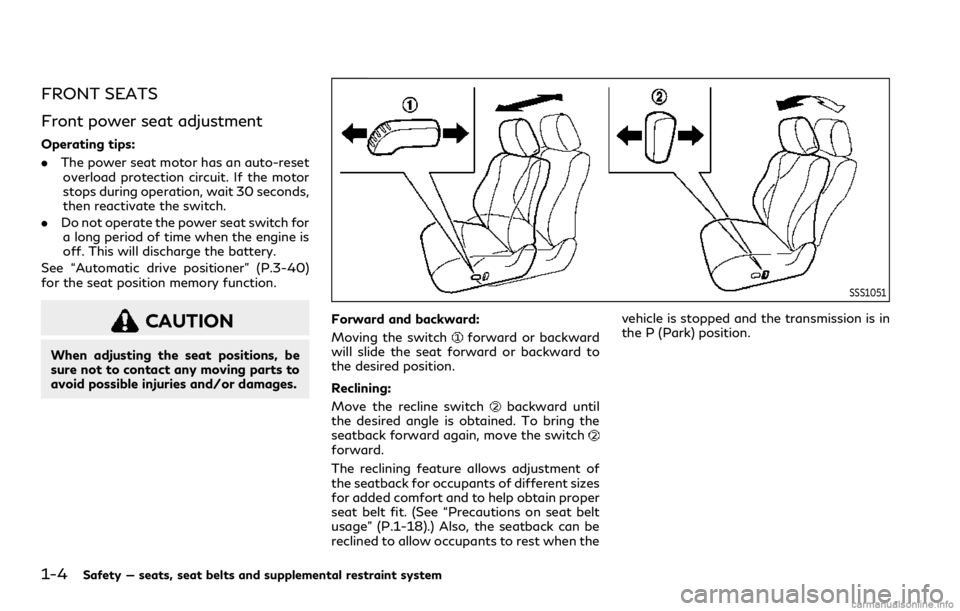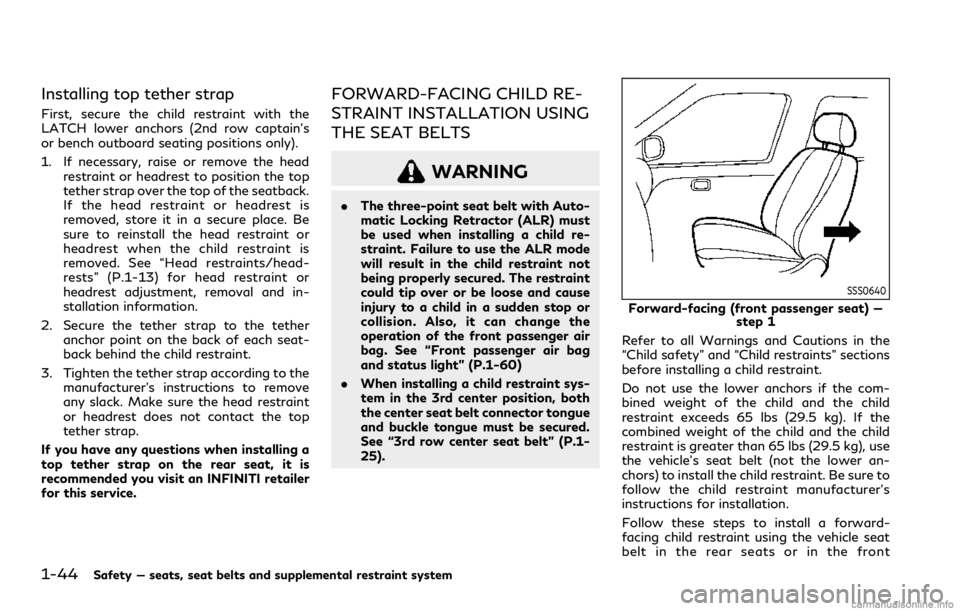1-4 INFINITI QX80 2021 Owner's Manual
[x] Cancel search | Manufacturer: INFINITI, Model Year: 2021, Model line: QX80, Model: INFINITI QX80 2021Pages: 529, PDF Size: 2.05 MB
Page 11 of 529

INFINITI CUSTOMER CARE PROGRAM
INFINITI CARES ...
Both INFINITI and your INFINITI retailer are dedicated to serving all your automotive needs. Your satisfaction with your vehicle and your
INFINITI retailer are our primary concerns. Your INFINITI retailer is always available to assist you with all your automobile sales and service
needs.
However, if there is something that your
INFINITI retailer cannot assist you with or
you would like to provide INFINITI directly
with comments or questions, please contact
our (INFINITI’s) Consumer Affairs Depart-
ment using our toll-free number:For U.S. customers1-800-662-6200
For Canadian customers 1-800-361-4792
The Consumer Affairs Department will ask
for the following information:
. Your name, address, and telephone num-
ber
. Vehicle identification number (on dash
panel)
. Date of purchase
. Current odometer reading
. Your INFINITI retailer’s name
. Your comments or questions
OR You can write to INFINITI with the informa-
tion on the left at:
For U.S. customersINFINITI Division
Nissan North America, Inc.
Consumer Affairs Department
P.O. Box 685003
Franklin, TN 37068-5003
or via e-mail at:
[email protected]
For Canadian customers INFINITI Division
Nissan Canada Inc.
5290 Orbitor Drive
Mississauga, Ontario L4W 4Z5
or via e-mail at:
information.centre@nissancanada.
com If you prefer, visit us at:
www.InfinitiUSA.com (for U.S. customers)
or
www.Infiniti.ca (for Canadian customers)
We appreciate your interest in INFINITI and
thank you for buying a quality INFINITI
vehicle.
Page 15 of 529

0-2Illustrated table of contents
WAA0130X
1. Seat belt for 3rd row center seat(P.1-25)
2. Roof-mounted curtain side-impact and rollover supplemental air bags (P.1-52)
3. Head Restraints (P.1-13) — Front-seat Active Head Restraints
(P.1-17)
4. Seat belts (P.1-18)
5. Front seat-mounted side-impact sup- plemental air bags (P.1-52) 6. Supplemental front-impact air bags
(P.1-52)
7. Child restraint anchor points (for top tether strap child restraint) (P.1-44,
P.1-48)
8. 3rd row seats (P.1-8) — Child restraints (P.1-31)
9. LATCH (Lower Anchors and Tethers for CHildren) system (P.1-34)
10. Armrest (2nd row seat) (P.1-10)
11. 2nd row seats (P.1-5) — Child restraints (P.1-31)
12. Seat belt pretensioner (P.1-67)
13. Front armrest (P.1-10)
14. Front seats (P.1-4) — Occupant classification sensors
(weight sensors) (P.1-58)
15. Front passenger air bag status light (P.1-60)
SEATS, SEAT BELTS AND
SUPPLEMENTAL RESTRAINT
SYSTEM (SRS)
Page 28 of 529

1 Safety — seats, seat belts and supplementalrestraint system
Seats ........................................................................\
.............. 1-3
Front seats .................................................................... 1-4
2nd row seats ............................................................... 1-5
3rd row seats ............................................................... 1-8
Armrest (if so equipped) .......................................... 1-10
Flexible seating .......................................................... 1-10
Head restraints/headrests ........................................... 1-13 Adjustable head
restraint/headrest components ............................ 1-14
Non-adjustable head
restraint/headrest components ............................ 1-15
Remove ........................................................................\
1-15
Install ........................................................................\
.... 1-16
Adjust ........................................................................\
... 1-16
Front-seat Active Head Restraint ........................ 1-17
Seat belts ........................................................................\
.. 1-18
Precautions on seat belt usage ............................. 1-18
Pregnant women ....................................................... 1-21
Injured persons ........................................................... 1-21
Pre-crash seat belts with comfort function
(if so equipped for front seats) ............................. 1-21
Three-point type seat belt ...................................... 1-21
Seat belt extenders ................................................... 1-28
Seat belt maintenance ............................................. 1-28 Child safety ...................................................................... 1-29
Infants ........................................................................\
1-30
Small children ........................................................... 1-30
Larger children ......................................................... 1-30
Child restraints ................................................................ 1-31 Precautions on child restraints ............................ 1-31
Lower Anchors and Tethers for CHildren
System (LATCH) ...................................................... 1-33
Top tether strap child restraint ........................... 1-36
Rear-facing child restraint installation
using LATCH ............................................................ 1-37
Rear-facing child restraint installation using
the seat belts ............................................................ 1-39
Forward-facing child restraint installation
using LATCH ............................................................ 1-41
Forward-facing child restraint installation
using the seat belts ................................................ 1-44
Booster seats ........................................................... 1-48
Supplemental restraint system .................................. 1-52
Precautions on supplemental
restraint system ....................................................... 1-52
INFINITI Advanced Air Bag System
(front seats) .............................................................. 1-58
Front seat-mounted side-impact supplemental
air bag and roof-mounted curtain side-impact
and rollover supplemental air bag systems ..... 1-65
Page 31 of 529

1-4Safety — seats, seat belts and supplemental restraint system
FRONT SEATS
Front power seat adjustment
Operating tips:
.The power seat motor has an auto-reset
overload protection circuit. If the motor
stops during operation, wait 30 seconds,
then reactivate the switch.
. Do not operate the power seat switch for
a long period of time when the engine is
off. This will discharge the battery.
See “Automatic drive positioner” (P.3-40)
for the seat position memory function.
CAUTION
When adjusting the seat positions, be
sure not to contact any moving parts to
avoid possible injuries and/or damages.
SSS1051
Forward and backward:
Moving the switch
forward or backward
will slide the seat forward or backward to
the desired position.
Reclining:
Move the recline switch
backward until
the desired angle is obtained. To bring the
seatback forward again, move the switch
forward.
The reclining feature allows adjustment of
the seatback for occupants of different sizes
for added comfort and to help obtain proper
seat belt fit. (See “Precautions on seat belt
usage” (P.1-18).) Also, the seatback can be
reclined to allow occupants to rest when the vehicle is stopped and the transmission is in
the P (Park) position.
Page 59 of 529

1-32Safety — seats, seat belts and supplemental restraint system
forward-facing child restraint in
the front seat, see “Forward-
facing child restraint installation
using the seat belts” (P.1-44).
— Even with the INFINITI Advanced Air Bag System, never install a
rear-facing child restraint in the
front seat. An inflating air bag
could seriously injure or kill a child.
A rear-facing child restraint must
only be used in the rear seat.
— Be sure to purchase a child re- straint that will fit the child and
vehicle. Some child restraints may
not fit properly in your vehicle.
— Child restraint anchor points are designed to withstand loads from
child restraints that are properly
fitted.
— Never use the anchor points for adult seat belts or harnesses.
— A child restraint with a top tether strap should not be used in the
front passenger seat.
— Keep seatbacks as upright as possible after fitting the child
restraint.
— Infants and children should al- ways be placed in an appropriate child restraint while in the vehicle.
. When the child restraint is not in use,
keep it secured with the LATCH
system or a seat belt. In a sudden
stop or collision, loose objects can
injure occupants or damage the ve-
hicle.
CAUTION
A child restraint in a closed vehicle can
become very hot. Check the seating
surface and buckles before placing a
child in the child restraint.
This vehicle is equipped with a universal child
restraint anchor system, referred to as the
LATCH (Lower Anchors and Tethers for
CHildren) system. Some child restraints in-
clude rigid or webbing-mounted attach-
ments that can be connected to these
anchors.
For details, see “Lower Anchors and Tethers
for CHildren System (LATCH)” (P.1-33).
If you do not have a LATCH compatible child
restraint, the vehicle seat belts can be used.
Several manufacturers offer child restraints
for infants and small children of various
sizes. When selecting any child restraint, keep the following points in mind:
.
Choose only a restraint with a label
certifying that it complies with Federal
Motor Vehicle Safety Standard 213 or
Canadian Motor Vehicle Safety Stan-
dard 213.
. Check the child restraint in your vehicle to
be sure it is compatible with the vehicle’s
seat and seat belt system.
. If the child restraint is compatible with
your vehicle, place your child in the child
restraint and check the various adjust-
ments to be sure the child restraint is
compatible with your child. Choose a
child restraint that is designed for your
child’s height and weight. Always follow
all recommended procedures.
. If the combined weight of the child and
child restraint is less than 65 lbs (29.5
kg), you may use either the LATCH lower
anchors or the seat belt to install the
child restraint (not both at the same
time).
. If the combined weight of the child and
child restraint is greater than 65 lbs (29.5
kg), use the vehicle’s seat belt (not the
lower anchors) to install the child re-
straint.
. Be sure to follow the child restraint
manufacturer’s instructions for installa-
tion.
Page 67 of 529

1-40Safety — seats, seat belts and supplemental restraint system
SSS0654
Rear-facing — step 2
2. Route the seat belt tongue through the child restraint and insert it into the buckle
until you hear and feel the latch engage.
Be sure to follow the child restraint
manufacturer’s instructions for belt
routing.
SSS0655
Rear-facing — step 3
3. Pull the shoulder belt until the belt is fully extended. At this time, the seat belt
retractor is in the Automatic Locking
Retractor (ALR) mode (child restraint
mode). It reverts to the Emergency
Locking Retractor (ELR) mode when
the seat belt is fully retracted.
SSS0656
Rear-facing — step 4
4. Allow the seat belt to retract. Pull up on the shoulder belt to remove any slack in
the belt.
Page 68 of 529

SSS0657
Rear-facing — step 5
5. Remove any additional slack from the seat belt; press downward and rearward
firmly in the center of the child restraint
to compress the vehicle seat cushion and
seatback while pulling up on the seat
belt.
SSS0658
Rear-facing — step 6
6. After attaching the child restraint, test it before you place the child in it. Push it
from side to side while holding the child
restraint near the seat belt path. The
child restraint should not move more
than 1 inch (25 mm), from side to side.
Try to tug it forward and check to see if
the belt holds the restraint in place. If the
restraint is not secure, tighten the seat
belt as necessary, or put the restraint in
another seat and test it again. You may
need to try a different child restraint. Not
all child restraints fit in all types of
vehicles.
7. Check to make sure that the child restraint is properly secured prior to each use. If the seat belt is not locked, repeat
steps 1 through 6.
After the child restraint is removed and the
seat belt fully retracted, the ALR mode (child
restraint mode) is canceled.
FORWARD-FACING CHILD RE-
STRAINT INSTALLATION USING
LATCH
Refer to all Warnings and Cautions in the
“Child safety” and “Child restraints” sections
before installing a child restraint.
Do not use the lower anchors if the com-
bined weight of the child and the child
restraint exceeds 65 lbs (29.5 kg). If the
combined weight of the child and the child
restraint is greater than 65 lbs (29.5 kg), use
the vehicle’s seat belt (not the lower an-
chors) to install the child restraint. Be sure to
follow the child restraint manufacturer’s
instructions for installation.
Follow these steps to install a forward-
facing child restraint using the LATCH
system:
1. Position the child restraint on the seat. Always follow the child restraint manu-
facturer’s instructions.
Safety — seats, seat belts and supplemental restraint system1-41
Page 69 of 529

1-42Safety — seats, seat belts and supplemental restraint system
JVR0637X
Forward-facing web-mounted — step 2
2. Secure the child restraint anchor attach- ments to the LATCH lower anchors.
Check to make sure the LATCH attach-
ment is properly attached to the lower
anchors.
If the child restraint is equipped with a
top tether strap, route the top tether
strap and secure the tether strap to the
tether anchor point. See “Installing top
tether strap” (P.1-44). Do not install
child restraints that require the use of a
top tether strap in seating positions that
do not have a top tether anchor.
JVR0638X
Forward-facing rigid-mounted — step 2
3. The back of the child restraint should be secured against the vehicle seatback.
If necessary, adjust or remove the head
restraint to obtain the correct child
restraint fit. If the head restraint is
removed, store it in a secure place. Be
sure to reinstall the head restraint when
the child restraint is removed. See “Head
restraints/headrests” (P.1-13) for head
restraint adjustment information.
If the seating position does not have an
adjustable head restraint or a headrest
and it is interfering with the proper child
restraint fit, try another seating position
or a different child restraint.
SSS0647
Forward-facing — step 4
4. For child restraints that are equipped with webbing-mounted attachments, re-
move any additional slack from the
anchor attachments. Press downward
and rearward firmly in the center of the
child restraint with your knee to com-
press the vehicle seat cushion and seat-
back while tightening the webbing of the
anchor attachments.
5. Tighten the tether strap according to the manufacturer’s instructions to remove
any slack.
Page 70 of 529

SSS0638
Forward-facing — step 6
6. After attaching the child restraint, test it before you place the child in it. Push it
from side to side while holding the child
restraint near the LATCH attachment
path. The child restraint should not move
more than 1 inch (25 mm), from side to
side. Try to tug it forward and check to
see if the LATCH attachment holds the
restraint in place. If the restraint is not
secure, tighten the LATCH attachment
as necessary, or put the restraint in
another seat and test it again. You may
need to try a different child restraint. Not
all child restraints fit in all types of
vehicles. 7. Check to make sure the child restraint is
properly secured prior to each use. If the
child restraint is loose, repeat steps 1
through 6.
JVR0619X
2nd row captain’s seat
JVR0620X
2nd row bench seat
Safety — seats, seat belts and supplemental restraint system1-43
Page 71 of 529

1-44Safety — seats, seat belts and supplemental restraint system
Installing top tether strap
First, secure the child restraint with the
LATCH lower anchors (2nd row captain’s
or bench outboard seating positions only).
1. If necessary, raise or remove the headrestraint or headrest to position the top
tether strap over the top of the seatback.
If the head restraint or headrest is
removed, store it in a secure place. Be
sure to reinstall the head restraint or
headrest when the child restraint is
removed. See “Head restraints/head-
rests” (P.1-13) for head restraint or
headrest adjustment, removal and in-
stallation information.
2. Secure the tether strap to the tether anchor point on the back of each seat-
back behind the child restraint.
3. Tighten the tether strap according to the manufacturer’s instructions to remove
any slack. Make sure the head restraint
or headrest does not contact the top
tether strap.
If you have any questions when installing a
top tether strap on the rear seat, it is
recommended you visit an INFINITI retailer
for this service.
FORWARD-FACING CHILD RE-
STRAINT INSTALLATION USING
THE SEAT BELTS
WARNING
. The three-point seat belt with Auto-
matic Locking Retractor (ALR) must
be used when installing a child re-
straint. Failure to use the ALR mode
will result in the child restraint not
being properly secured. The restraint
could tip over or be loose and cause
injury to a child in a sudden stop or
collision. Also, it can change the
operation of the front passenger air
bag. See “Front passenger air bag
and status light” (P.1-60)
. When installing a child restraint sys-
tem in the 3rd center position, both
the center seat belt connector tongue
and buckle tongue must be secured.
See “3rd row center seat belt” (P.1-
25).
SSS0640
Forward-facing (front passenger seat) —
step 1
Refer to all Warnings and Cautions in the
“Child safety” and “Child restraints” sections
before installing a child restraint.
Do not use the lower anchors if the com-
bined weight of the child and the child
restraint exceeds 65 lbs (29.5 kg). If the
combined weight of the child and the child
restraint is greater than 65 lbs (29.5 kg), use
the vehicle’s seat belt (not the lower an-
chors) to install the child restraint. Be sure to
follow the child restraint manufacturer’s
instructions for installation.
Follow these steps to install a forward-
facing child restraint using the vehicle seat
belt in the rear seats or in the front